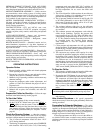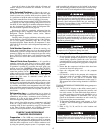
63
Check Optional Pumpout System Controls
and Compressor —
Controls include an on/off switch,
a 3-amp fuse, the compressor overloads, an internal thermostat,
a compressor contactor, and a refrigerant high pressure cutout.
The high pressure cutout is factory set to open at 161 psig
(1110 kPa) and reset at 130 psig (896 kPa). Ensure the water-
cooled condenser has been connected. Loosen the compressor
holddown bolts to allow free spring travel. Open the compres-
sor suction and discharge the service valves. Ensure oil is visi-
ble in the compressor sight glass. Add oil if necessary.
See the Pumpout and Refrigerant Transfer Procedures and
Optional Pumpout System Maintenance sections, pages 67 and
75, for details on the transfer of refrigerant, oil specifications,
etc.
Table 9 — Control Test Menu Functions
High Altitude Locations —
Because the chiller is ini-
tially calibrated at sea level, it is necessary to recalibrate the
pressure transducers if the chiller has been moved to a high alti-
tude location. See the calibration procedure in the Trouble-
shooting Guide section.
Charge Refrigerant into Chiller
The standard 19XR chiller is shipped with the refrigerant
already charged in the vessels. However, the 19XR may be or-
dered with a nitrogen holding charge of 15 psig (103 kPa).
Evacuate the nitrogen from the entire chiller, and charge the
chiller from refrigerant cylinders.
CHILLER EQUALIZATION WITHOUT A PUMPOUT
UNIT
To equalize the pressure differential on a refrigerant isolated
19XR chiller, use the terminate lockout function of the CON-
TROL TEST on the SERVICE menu. This helps to turn on
pumps and advises the operator on proper procedures.
The following steps describe how to equalize refrigerant
pressure in an isolated 19XR chiller without a pumpout unit.
1. Access terminate lockout function on the CONTROL
TEST screen.
2.
3. Slowly open the refrigerant cooling isolation valve. The
chiller cooler and condenser pressures will gradually
equalize. This process takes approximately 15 minutes.
4. Once the pressures have equalized, the cooler isolation
valve, the condenser isolation valve, and the hot gas isola-
tion valve may now be opened. Refer to Fig. 29 and 30,
for the location of the valves.
TESTS TO BE
PERFORMED
DEVICES TESTED
1. CCM Thermistors Entering Chilled Water
Evaporator Refrigerant Tempera-
ture (ICVC only)
Leaving Chilled Water
Entering Condenser Water
Leaving Condenser Water
Remote Reset Sensor
Comp Discharge Temp
Oil Sump Temp
Comp Motor Winding Temp
Space Temperature 1
Space Temperature 2
2. CCM Pressure
Transducers
Evaporator Pressure
Condenser Pressure
Oil Pump Delta P
Condenser Water Delta P
Transducer Voltage Ref
3. Pumps Chilled Water — Confirm pressure
Condenser Water — Confirm
Delta P
4. Discrete Outputs Oil Heater Relay
Hot Gas Bypass Relay
Tower Fan Relay Low
Tower Fan Relay High
Alarm Relay
Shunt Trip Relay
5. Guide Vane Actuator Open/Close
6. Diffuser Actuator Open/Close
7. Pumpdown Lockout When using pumpdown/lockout,
observe freeze up precautions when
removing charge:
Instructs operator which valves to
close and when.
Starts chilled water and condenser
water pumps and confirms flows.
Monitors
Evaporator pressure
Condenser pressure
Evaporator temperature during
pumpout procedures
Turns pumps off after pumpdown.
Locks out compressor.
8 Terminate Lockout Starts pumps and monitors flows.
Instructs operator which valves to
open and when.
Monitors
Evaporator pressure
Condenser pressure
Evaporator temperature during
charging process
Terminates compressor lockout.
The transfer, addition, or removal of refrigerant in spring
isolated chillers may place severe stress on external piping
if springs have not been blocked in both up and down
directions.
Always operate the condenser and chilled water pumps
during charging operations to prevent freeze-ups.
When equalizing refrigerant pressure on the 19XR chiller
after service work or during the initial chiller start-up, do
not use the discharge isolation valve to equalize. Either the
motor cooling isolation valve or the charging hose (con-
nected between the pumpout valves on top of the cooler
and condenser) should be used as the equalization valve.
Whenever turning the discharge isolation valve, be sure to
reattach the valve locking device. This prevents the valve
from opening or closing during service work or during
chiller operation.
IMPORTANT: Turn on the chilled water and con-
denser water pumps to prevent freezing.


















